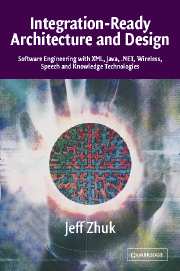 Integration-Ready Architecture and Design
Integration-Ready Architecture and Design Book contents
- Frontmatter
- Contents
- Preface
- Contributors
- Acknowledgments
- Introduction
- Notes for Educators: AMA Teaching Methods
- Chapter 1 Collaborative Engineering
- Chapter 2 Software Architecture and Integration Technologies
- Chapter 3 From a Specific Task to “Integration-Ready” Components
- Chapter 4 Integration with Voice
- Chapter 5 An Introduction to Knowledge Technologies
- Chapter 6 Write Once
- Chapter 7 The New Generation of Client–Server Software
- Chapter 8 Wireless Technologies
- Chapter 9 Programming Wireless Application Protocol Applications
- Chapter 10 A Single JavaCard Identity Key for All Doors and Services
- Chapter 11 The J2ME Family
- Chapter 12 Speech Technologies on the Way to a Natural User Interface
- Chapter 13 Integration with Knowledge
- Chapter 14 Distributed Life in the JXTA and Jini Communities
- Appendix 1 Java and C#: A Saga of Siblings
- Appendix 2 XML and Web Services
- Appendix 3 Source Examples
- Index
Chapter 10 - A Single JavaCard Identity Key for All Doors and Services
Published online by Cambridge University Press: 17 August 2009
- Frontmatter
- Contents
- Preface
- Contributors
- Acknowledgments
- Introduction
- Notes for Educators: AMA Teaching Methods
- Chapter 1 Collaborative Engineering
- Chapter 2 Software Architecture and Integration Technologies
- Chapter 3 From a Specific Task to “Integration-Ready” Components
- Chapter 4 Integration with Voice
- Chapter 5 An Introduction to Knowledge Technologies
- Chapter 6 Write Once
- Chapter 7 The New Generation of Client–Server Software
- Chapter 8 Wireless Technologies
- Chapter 9 Programming Wireless Application Protocol Applications
- Chapter 10 A Single JavaCard Identity Key for All Doors and Services
- Chapter 11 The J2ME Family
- Chapter 12 Speech Technologies on the Way to a Natural User Interface
- Chapter 13 Integration with Knowledge
- Chapter 14 Distributed Life in the JXTA and Jini Communities
- Appendix 1 Java and C#: A Saga of Siblings
- Appendix 2 XML and Web Services
- Appendix 3 Source Examples
- Index
Summary
Nothing is more powerful than an idea whose time has come.
—Victor HugoThis chapter turns the smallest Java Virtual Machine (JVM) running on a smart card into a powerful key that can open all doors.
WHAT IS A SMART CARD?
Imagine a regular plastic card (often called “plastic”) with either a microprocessor and/or a memory chip embedded into the card. The microprocessor can manipulate information on the card, whereas a memory chip (e.g., the one in a prepaid phone card) can undertake only a predefined operation performed by a card reader.
Smart cards, unlike magnetic-stripe cards, do not require remote access at the time of the transaction; they can carry all the necessary functions and information right on the card. Today, there are three categories of smart cards: microprocessor, memory, and optical memory.
Microprocessor cards have an 8-bit processor, 16 KB of read-only memory, and 512 bytes of random access memory. Their processing power is similar to the first personal computers. These cards can perform cryptography algorithms and are used to access, hold, and otherwise manage digital money; provide secure access to computer and phone networks; secure set-top boxes; and perform other functions.
Memory cards, which can hold up to 1 to 4 KB of data, represent the bulk of the 600 million smart cards sold last year, primarily for prepaid, disposable card applications like prepaid phone cards. Card readers (also known as card-accepting devices) perform fixed operations (e.g., add, subtract, and delete) on memory cards.
Optical memory cards have a piece of (optical) compact disk glued on their surface. Up to 4 MB of data can be stored on the card, once and forever.
- Type
- Chapter
- Information
- Integration-Ready Architecture and DesignSoftware Engineering with XML, Java, .NET, Wireless, Speech, and Knowledge Technologies, pp. 286 - 305Publisher: Cambridge University PressPrint publication year: 2004
